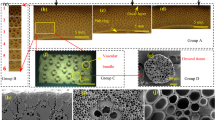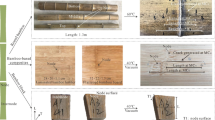Abstract
The bending properties of split bamboo culm were compared with those of spruce and beech wood specimens. The bamboo allowed large flexural deformation since its outer layer retains the tensile stress while the softer inner layer undergoes large compressive deformation. The results suggested that the combination of the fiber-rich outer part and the compressible inner part was responsible for the flexural ductility of split bamboo. To clarify the compressible nature of the inner part of bamboo, the longitudinal surfaces of the bamboo and wood specimens were microscopically observed before and after a large longitudinal compression. Although the wood specimens showed serious and localized buckling, the inner part of the bamboo specimens showed no such visible buckling. In the latter case, the foam-like parenchyma cells absorbed the large compressive deformation by their microscopic buckling and simultaneously, the alignment of sclerenchyma fibers was maintained by the surrounding parenchyma matrix. The flexural elasticity of the bamboo was compared to that of the wood in respect of remaining strain during cyclic bending tests. No clear difference was recognized between their remaining strains. This fact indicated that the bamboo was not so flexible elastically, although its fiber–foam combination and intelligent fiber distribution improve flexural ductility.















Similar content being viewed by others
References
Abd Latif M (1993) Effects of age and height on the machining properties of Malaysian bamboo. J Trop For Sci 5:528–535
Chuma S, Hirohashi M, Ohgama T, Kasahara Y (1990) Composite structure and tensile properties of mousou bamboo (in Japanese). Zairyou (J Soc Mater Sci Jpn) 39:847–851
Imai T, Majima S, Fujita M, Saiki H (1995) Cellular structures in culm internodes of three Phyllostachys species - Madake, Hachiku and Mosochiku. Bull Kyoto Univ For 67:147–157
Inokuchi Y (2003) Utilization of bamboo from the point of view of mechanical properties (in Japanese). Wood Industry 58:157–164
Inokuchi Y, Fushitani M, Chuma S, Ozawa M, Kubo T, Sato K (1997) Effects of volume fraction of bundle sheath on the vibrational properties of bamboo. Mokuzai Gakkaishi 43:391–398
Inokuchi Y, Fushitani M, Kubo T, Sato K (1999) Effects of water extractives on the moisture-content dependence of vibrational properties of bamboo. Mokuzai Gakkaishi 45:77–84
Inokuchi Y, Fushitani M, Kubo T, Sato K (2002) Effect of volume fraction of bundle sheath and water extractives on bending creep behavior of bamboo under changing moisture condition. Mokuzai Gakkaishi 48:413–424
Kitazawa K, Takahama M, Ogawa H (2003) Possibility of nosing of bamboo. J Jpn Soc Technol Plast 44:63–65
Kitin P, Fujii T, Abe H, Funada R (2004) Anatomy of the vessel network within and between tree rings of Fraxinus lanuginosa (Oleaceae). Am J Bot 91:779–788
Kiyooka T (2001) Bamboo materials (in Japanese). Management-sha, Tokyo, p 173 (ISBN 4-8378-0405-5)
Liese W (1998) The anatomy of bamboo culms. International network for bamboo and ratans (INBAR), Beijing, Tech rep no.18
Liese W, Weiner G (1996) Ageing of bamboo culms. Wood Sci Technol 30:77–89
Ma L, Kawai S, Sasaki H (1999) Manufacture of bamboo-cement composite VI: effect of silica fume addition and heat-treatment on properties of hot-pressed boards. Mokuzai Gakkaishi 45:25–33
Matsumoto K, Yamauchi H, Yamada H, Yoshida H (2001) Manufacture and properties of fiberboard made from moso bamboo. Mokuzai Gakkaishi 47:111–119
Mori M (1984) An example of plain board processing of bamboo by microwave heating. Bamboo J 2:47–49
Murphy R, Sulaiman O, Alvin KL (1997) Ultrastructural aspects of cell wall organization in bamboos. In: Chapman G (ed) The bamboos. Linnaean Society, London, pp 305–312
Murphy RJ, Alvin KL (1997) Fibre maturation in the bamboo Gigantochloa scortechinii. IAWA Bull 18:147–156
Nugroho N, Ando N (2000) Development of structural composite products made from bamboo I: fundamental properties of bamboo zephyr board. J Wood Sci 46:68–74
Okubo K, Fujii T, Yamamoto Y (2004) Development of bamboo-based polymer composites and their mechanical properties. Composites Part A 35:377–383
Parameswaran N, Liese W (1976) On the fine structure of bamboo fibres. Wood Sci Technol 10:231–246
Parameswaran N, Liese W (1980) Ultrastructural aspects of bamboo cells. Cellulose Chem Technol 14:587–609
Shito T, Okubo K, Fujii T (2002) Development and mechanical properties of eco-composites using bamboo fiber. Bamboo J 19:15–23
Takagi H, Ichihara Y (2004) Effect of fiber length on mechanical properties of “green” composites using a starch-based resin and short bamboo fibers. JMSE Int J Ser A 47(4):551–555
Tung NH, Yamamoto H, Matsuoka T, Fujii T (2004) Effect of surface treatment on interfacial strength between bamboo fiber and PP resin. JMSE Int J Ser A 47(4):561–565
Yaoa W, Lib Z (2003) Flexural behavior of bamboo-fiber-reinforced mortar laminates. Cem Concr Res 33:15–19
Yonekura M (1992) Development on expansive technique of bamboo (Mosochiku). Bamboo J 10:67–74
Zhang M (1994) Relationship between tensile strength of natural fibers and their sizes. Wood Res Tech Notes 30:32–39
Zhang M (1997) The study of high performance bio-based composite board manufactured from lignocellulosic materials. Wood Res Tech Notes 33:33–70
Zhang J, Wang R, Ma N, Zhang W (1995) Fibre morphology and main physical and chemical properties of some bamboo wood of Phyllostachys. For Res 8:54–61
Author information
Authors and Affiliations
Corresponding author
Rights and permissions
About this article
Cite this article
Obataya, E., Kitin, P. & Yamauchi, H. Bending characteristics of bamboo (Phyllostachys pubescens) with respect to its fiber–foam composite structure. Wood Sci Technol 41, 385–400 (2007). https://doi.org/10.1007/s00226-007-0127-8
Received:
Published:
Issue Date:
DOI: https://doi.org/10.1007/s00226-007-0127-8




